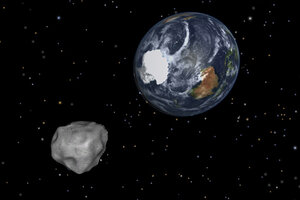Going rogue could be the norm for asteroids, say astronomers
The discovery of a large number of so-called rogue asteroids suggests a tumultuous early history of our solar system, say researchers.

This image provided by NASA/JPL-Caltech shows a simulation of asteroid 2012 DA14 approaching from the south as it passed through the Earth-moon system last year.
AP Photo/NASA/JPL-Caltech
A bunch of 'rogue' asteroids could redefine our understanding of the origins of our solar system.
Researchers from MIT and the Paris Observatory, who studied 100,000 space rocks for their size, composition, and location, identified a number of rogues scattered throughout the main asteroid belt, between Mars and Jupiter.
So far, scientists believed that asteroids that are closer to the sun have surfaces that are mostly rocky and that those farther away from the sun are cold, dark, and rich in carbon.
But they also identified many asteroids all over the asteroid belt that did not follow this location-composition correlation, lead author Francesca DeMeo, a Hubble postdoctoral fellow at the Harvard-Smithsonian Center for Astrophysics, told the Monitor.
In other words, these ‘new’ asteroids were positioned close to the sun, but their surfaces were rich in carbon, and vice versa, she says, comparing the asteroids to a bunch of colored marbles scattered everywhere with no particular pattern.
“First we found one asteroid but you could explain that as an exception, but then we found ten of them,” she says.
Dr. DeMeo along with co-author Benoit Carry of the Paris Observatory, then plotted an asteroid map by examining a huge range of asteroids with diameters (across) ranging from 3 miles to 621 miles, says DeMeo.
To begin with, the researchers used data from the Sloan Digital Sky Survey in New Mexico and found that the asteroid belt is more diverse than previously realized, especially with smaller asteroids, according to press releases from MIT and Harvard-Smithsonian Center for Astrophysics.
But what, exactly, sent these asteroids scattering?
The early solar system was in a great state of turbulence before they moved to their current positions, as we know them today, says DeMeo.
What might have happened is that Jupiter could have drifted closer to the sun. In the process it could have dragged asteroids that were originally formed away from the sun, before moving back out to its current position, she says.
“It’s like Jupiter bowled a strike through the asteroid belt," she said. "Everything that was there moves, so you have this melting pot of material coming from all over the solar system."
This early pinballing of asteroids around the solar system might have made Earth habitable. For example---colder asteroids, which likely had ice, might have collided with Earth, leaving traces of ice that might have melted into water.
“The story of what the asteroid belt is telling us also relates to how Earth developed water, and how it stayed in this Goldilocks region of habitability today,” DeMeo said.
The findings were published in a paper titled “Solar System evolution from compositional mapping of the asteroid belt,” on Jan. 30 issue of Nature, a science journal.

